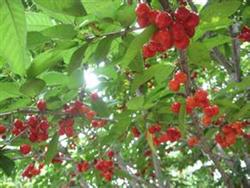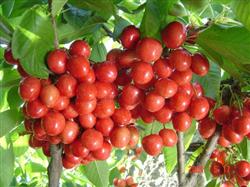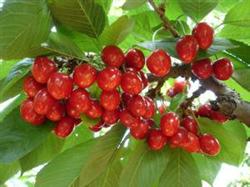Early, high-yield and efficient cultivation of sweet cherry

1. According to the characteristics of drought tolerance, waterlogging resistance, cold resistance, salt tolerance and shallow root system of sweet cherry, sweet cherry orchard should be located in loam or sandy loam with deep soil layer, loose soil, low groundwater level, no stagnant water, good drainage and irrigation conditions and not easy to suffer wind damage. It is not suitable to plant sweet cherry in the area with high groundwater level, too heavy soil, too much Rain Water in summer and can not be drained in a short time. two。 At present, the main varieties and pollinated varieties in Dalian are Red Lantern, Red Honey, Hongyan, Jiahong and Juhong selected by Dalian Institute of Agricultural Sciences, and the varieties being promoted are Shang Shang Jin, Gao Sha, Sato Jin, Sha Hondou and so on. These varieties have excellent quality, beautiful appearance and high economic value. Generally, red lights are the main varieties. The configuration of pollination trees should not be less than 30%. If the three main varieties can pollinate each other, they should each account for 1%. The pollination varieties that can be configured for different main varieties are as follows: table 1 Table 1 Sweet Cherry main varieties and pollination varieties Hongdenihongmi, Binku, Dazi, Jiahong Dazi Yantai, Crystal, Hongfeng, Na Weng, Binkunaeng Dazi, Renny, Pioneer Rennaweng, Binku Hongmi Red Lamp, Hongyan, The top brocade red lights, Nanyang Honey, Sato Kam, Beiguang Sato Kam Nanyang, Sand Honey Dou, Zhengguang Kam Nanyang, Sato Kam Nanyang, Sato Kam Dongxiang Jin Red Light, Zhengguang Jin 3. Colonization is generally planted after soil thawing in spring to before seedling germination. Dalian area was planted in late March, and the survival rate was high. 83 plants (2mX4m) or 56 plants (3mx4m) can be planted every 666.7 square meters. Dig a pit of 0.5m2 according to the distance between trees and rows, apply organic fertilizer 30kg to each pit, and cover the soil to fill the pit. One-year-old seedlings with no injuries, strong roots and well-developed roots should be selected. Before planting, the seedlings should be soaked in water for 12 hours, and then dipped in ABT rooting powder solution. When planting, the grafting interface is slightly higher than the ground, watering and settling to make the interface flush with the ground, and then covered with plastic film. After drying, cover the plastic bag, cover the plastic belt, and tie the lower part of the mouth, which can prevent insects and improve the survival rate. 4. The tree shape of shaping and pruning sweet cherry generally chooses improved spindle shape and multi-axis extension shape. Improved spindle shape, set height 40cm. From the first ten days of June to the first ten days of August, the new shoots that had always been upright were left as the central trunk, and the rest of the shoots were cut and left about 30cm. In the next spring, the central trunk was cut and the main side branches were cut by 30-40cm. From the first ten days of June to the first ten days of August, the new shoots were left as the central stem, and the rest of the new shoots were cut and kept 30cm for 3 times, and the new shoots were pulled horizontally in autumn. The practice in the third year is the same as in the second year. It can be molded in 3 years, the dry height is about 40cm, the tree height is 2.5ml 3.2m, there are 8-10 main branches of the whole tree, and 10-15 large fruiting branches are directly planted on each main branch. This kind of tree shape can rapidly increase the number of branches, strong three-dimensional fruiting ability and high population benefit. The branch quantity of 4-year-old 666.7 square meters can reach about 60, 000, which is very suitable for Hongmi, Shangjin and other varieties with high germination rate, strong branching ability and moderate tree potential. the output of 666.7 square meters in the fourth year is 257.3kg and 229.9kg respectively, and the seventh year is 1950.5kg and 1625.8kg. In the middle of June of that year, the new shoots were kept upright as the central stem, and the rest were cut to 20-30cm when they were above 30cm. In the following spring, the central dry cut leaves 50-60cm, the main branch shears 20 Mel 30 cm and leaves 20-30cm on the first layer of prosperous new branches from June to July. Except for a central stem, the second layer leaves 20-3 OcmDepartment branches from August to September. The angle of pulling branches is larger (90 degrees or downward slope) for prosperous varieties such as red lanterns, and slightly smaller for moderate varieties such as Hongmi, the top brocade and so on (70 degrees 80 degrees). The pruning in the third year is the same as in the second year. It can be formed in 3 years, the tree height is 2ml 2.5m, the main branches of the whole tree are 12-15, and there are 3 lateral branches on the main branches, and the fruit branches are directly planted on the main and lateral branches. The tree is short and suitable for close planting, such as an erect variety with strong red light. Using this tree shape, it can quickly enter the peak fruiting period, with a yield of 666.7 square meters in the fourth year and 121.18kg in the seventh year. For example, the varieties with moderate growth of Hongmi and Shangjin are not suitable for use because of the decline in yield and premature senescence in the later stage, although they have entered the fruiting stage early. 5. Water and fertilizer management in Dalian area, sweet cherries should be irrigated four times a year. When the fruit after falling flowers, such as the size of soybeans (mid-late May), is irrigated with "hard core water", when sweet cherry trees grow and develop most vigorously and are most sensitive to water, irrigation can greatly reduce fruit drop (the fruit drop rates of irrigation and non-irrigation are 11% and 31%, respectively). Improve yield and quality, so it is necessary to irrigation frequently and fully. The fruit expands rapidly around the first ten days of June, and timely irrigation can increase the yield by 30% by 40%. After fruit harvest, flower bud differentiation is mainly carried out, in order to restore the tree body and ensure the normal flower bud differentiation, fertilization and irrigation should be applied immediately after harvest, but the amount of irrigation water is wet over the ground, and short-term drought after irrigation is beneficial to flower bud differentiation. Irrigation should not be excessive in the growing season of sweet cherries, and the soil moisture is generally kept at about 70% of the field capacity. At the beginning of November, "frozen water" should be irrigated with enough water. And fertilize it three times. Spraying 0.3% urea + 0.1% Mel 0.3% borax + potassium dihydrogen phosphate 600 times at flowering stage can increase the fruit setting rate by 13.1%, and the fruit setting rate of the top cherry can be increased by 39.7%. About 10 days after fruit harvest, 200kg was applied to fruit trees every 666.7 square meters, 100kg compound fertilizer for young trees and 2000kg in feces and urine of mature people. In autumn, in the second peak period of root growth, applying 5000kg organic fertilizer every 666.7 square meters can increase the storage nutrition of the tree. 6. Auxiliary pollination sweet cherry is a fruit tree with low self-pollination strength. Under the premise of configuring enough pollination trees, auxiliary pollination must be carried out, which can generally increase the flower fruit setting rate by 43.2% and bee release by 39.7%. 7. With the application of growth regulators, the vegetative growth of 3-4-year-old sweet cherry young trees is generally prosperous. Red honey, Zhengguang brocade, sand honey bean and other varieties can effectively control their vegetative growth through summer pruning, so that the reproductive growth and vegetative growth can develop in a balanced way. to achieve the goal of early fruit and early harvest. However, for varieties whose tree posture tends to be upright, such as red light, although pulling branches is adopted. Slow release, pruning, repeated coring and other measures can not control its growth, the proportion of long branches still accounts for more than 30%, affecting the flower bud formation of medium and short fruit branches. 15% PP3335g/ trees (5 square meters) can be applied to the projected area of red light crown in mid-August every year, and an average of 9.6 medium and short branches and 12.7 flower buds can be formed on each side branch, thus entering the fruiting stage earlier. 8. The overwintering protection of sweet cherry is a kind of fruit tree which likes temperature but is not resistant to cold. It is easy to suffer frost damage at low temperature in winter, and striping is easy to occur after being frozen. The use of antifreeze wax produced by Jinzhou paraffin factory can solve this problem. From late November to early December, after cold-resistant exercise, the tree was sprayed with the concentration of warm water 5 original solution 1. For 2-year-old red light trees, the striping rate of one-year-old branches decreased from 34.4% to 1.6% (the average of 5 trees).
- Prev

In what climate should western cherries be cultivated?
Western cherry (also known as big cherry) has not been introduced into China for only one hundred years. Cultivation is concentrated in the provinces along the coast of Bohai Bay, among which Shandong Province is the most. In recent years, many places have also been introduced and cultivated. However, they all show strong tree growth, long branches, few flower buds, serious falling flowers and fruits.
- Next

High-yield and efficient cultivation techniques of Sweet Cherry
Jinzhou District is located in the southern tip of Liaodong Peninsula, with an annual average temperature of 10 ℃, annual sunshine of 2505.5 h, annual precipitation of 500-700mm, and a frost-free period of about 180 days. Many hills and hills, loose soil, moderate permeability, suitable for the growth and development of sweet cherry, cultivation has a long history. But before 1998, due to a single variety, technology.
Related
- Moge, come on! The staff of the peasant association in the producing area of cantaloupe were frightened when the crowd gathered.
- Causes and Solutions of low Fruit setting rate of Apple
- Symptoms and control measures of passion fruit virus disease
- Fruit growing lesson: how do apple orchards keep high yields?
- Can you build orchards in the mountains? What are the pros and cons?
- How to manage the coloring period of Crisson grape?
- This paper introduces the processing technology of two kinds of fig products.
- How much is a month for retired teachers in rural areas by 2020?
- How can strawberry planting increase sugar content? We should pay attention to management in many aspects.
- What are the cultivation techniques on how to improve the yield of golden fruit?

